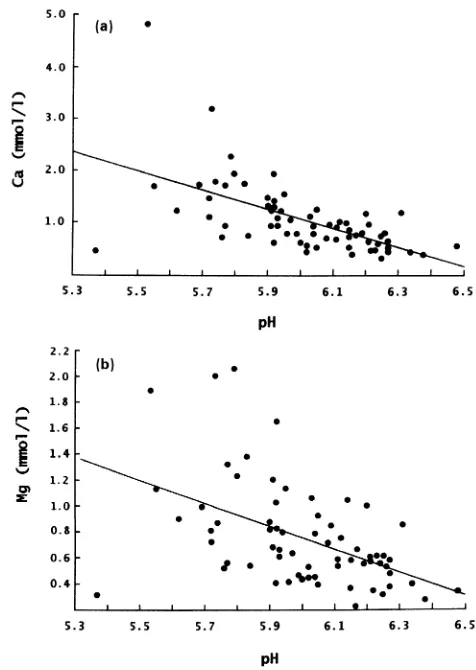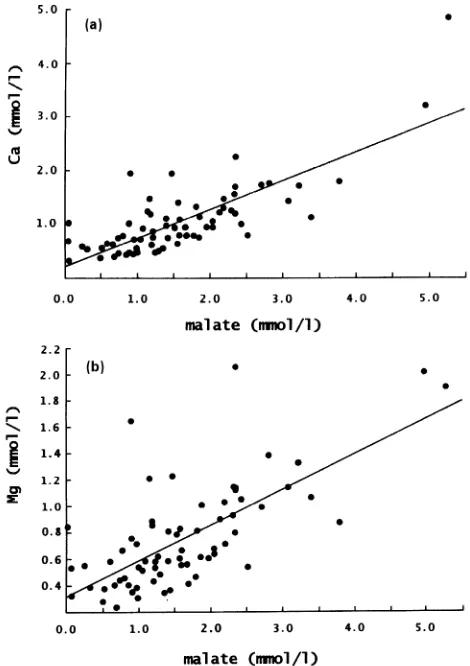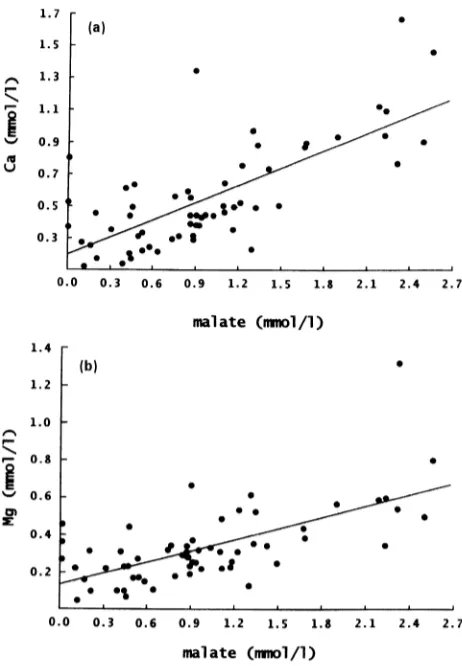Summary The presence and concentration of mineral nutri-ents and organic acids were analyzed in root xylem sap of mature beech trees (Fagus sylvatica L.). An interdependence between malate concentration, pH, and calcium and magne-sium concentrations was observed. Significant correlations were found between low pH values and high calcium and magnesium concentrations, low pH values and high malate concentration, and high malate concentration and high total calcium and magnesium concentrations. The observed corre-lations suggest that malic acid determines the chemical milieu of the xylem sap and tends to form complexes with hydrated or exchangeable adsorbed cations, thereby influencing the mobilization and translocation of calcium and magnesium in beech sapwood.
Keywords: Fagus sylvatica, mobilization, nutrient dynamics.
Introduction
Despite many studies, little is known about the cycling and storage of nutrients in adult trees. In particular, the mobiliza-tion and dynamics of transported substances, the axial and radial distribution patterns of elements and water, and the physiological processes in living, woody parenchyma are poorly understood. It has been suggested that the phenomenon of tree decline results from an imbalance of mineral nutrients (Ulrich et al. 1979). Consequently, analyzing xylem water to determine the distribution dynamics of nutrient elements and water within a tree is a useful pursuit in forest decline research. Conducting sapwood contains a variety of compounds, but little is known about their functions. Until recently, descrip-tions of the chemical composition of xylem sap of adult trees have usually been based on the analysis of bleeding sap (Es-siamah 1982, Godt 1986). There is evidence of increased concentrations of complexing agents, particularly citric, malic, and various amino acids (White et al. 1981a, 1981b, Clark et al. 1986, Wutcher and McDonald 1986, Andersen and Brod-beck 1989, Sauter and van Cleve 1992, Schneider et al. 1994) during the internal mobilization of nutrients that occurs before and during bud burst (Bollard 1953, Tromp and Ovaa 1967, Tromp 1979, Titus and Kang 1982, Ferguson et al. 1983, Moreno and Garcia-Martinez 1983). Most investigations of
this phenomenon have focused on analyses of feeder roots or aboveground plant components (Glavac et al. 1989, 1990a, 1990b, 1990c). To provide additional insight into the flow of elements, we have analyzed xylem sap in the water-conducting sapwood of large beech (Fagus sylvatica L.) roots (2--3 cm in diameter) during the growing season. The results in this paper are part of a larger study comparing the nutrients found in soil solution and xylem sap of beech roots. A correlation matrix of all measured paramters showed significant correlations be-tween malate and pH as well as calcium and magnesium concentrations. This finding is of interest because Heimerich (1993) obtained similar results in studies of tree trunks.
Materials and methods
Study sites
Soil and root samples were collected at two locations in North Hessen, Germany. The first site, a 152-year-old beech stand (Hordelymo-Fagetum), was located near Zierenberg at the Kleinen Gudenberg. The elevation of the site was 460 m, the average yearly temperature approximately 7 °C and the aver-age annual precipitation 650 mm. The brown forest soil, con-sisting of basalt debris, had a high humus content and a C/N ratio of 13.08 in the upper mineral layers. The soil solution had a mean pH of 5.45 ± 0.22, a base saturation of 79.2%, and an effective cation exchange capacity (CEC) of 104.8 mval kg−1. The study was carried out from May 18 to September 9, 1993, and 70 soil and 68 xylem sap samples were collected from the Zierenberg site during this period.
The second site, a 160-year-old beech stand (Luzulo Fagetum typicum) located in the Söhre (10 km south-east of the city of Kassel) was selected for its podsolic pseudogley earth. The elevation of the site was 480 m, the average yearly temperature approximately 7 °C and the average annual pre-cipitation 700--850 mm. The parent material was red sandstone covered by loess loam. The 0--15 cm soil layer had a pH of 4.26 ± 0.23, a C/N ratio of 17.77, a base saturation of 16% and an effective CEC of 67.3 mval kg−1. Seventy soil samples and 65 xylem sap samples were obtained from this site between May 5 and September 28, 1993.
Interdependence of pH, malate concentration, and calcium and
magnesium concentrations in the xylem sap of beech roots
JUDITH SCHELL
Arbeitsgruppe für Pflanzen-, Vegetations- und Landschaftsökologie, Fachbereich Biologie/Chemie, Universität/Gesamthochschule Kassel, Heinrich-Plett-Straße 40, D-34132 Kassel, Germany
Received May 23, 1996
Xylem sap extraction and measurements
During the 1993 growing season, roots (2--3 cm in diameter) were collected weekly at a minimum distance of 2.5--3 m from the base of the trunk. A segment of approximately 1 m in length was removed from each root, packed in a polyethylene bag, and refrigerated until laboratory processing. Before extraction of xylem sap, each root was washed carefully and cut in half. The freshly cut ends were scraped free of bark phloem (ap-proximately 3--4 cm) to prevent contamination during extrac-tion of xylem sap. The ends were then rinsed a second time with distilled water and blotted dry with filter paper. Xylem sap was extracted by means of a modified form of the Bollard method (Bollard 1953). The pH of the freshly obtained clear and colorless sap was measured with a glass electrode, and sap samples were deep-frozen until used for further measurements. To estimate the magnitude of contamination by damaged liv-ing cells, the ATP content was determined luminometrically (ATP-Biolumineszenz HS, No. 567 701, Boehringer Mannheim, Mannheim, Germany).
Concentrations of Ca, Mg, K, Na, Mn and Fe in the xylem sap were determined by atomic absorption spectrophotometry
(AAS, 3030, Perkin-Elmer, Norwall, CT), as described by König et al. (1989). The HGA technique of atomic absorption spectrophotometry (Perkin Elmer Zeeman 3030) was used to determine Cd and Pb concentrations in all samples. Concentra-tions of Al and Cu were measured by Inductively Coupled Plasma-Atomic Emission Spectrometry (ICP-AES, Spectro-Physics, Kleve, Germany). Anion (Cl−, SO42−, PO43−, NO3−, and malate) concentrations were determined by ion chromatogra-phy (BioLC 2000i/SP, Dionex Corp., Sunnyvale, CA). Malate concentration was also determined indirectly following enzy-matic reduction of NAD+ and spectrophotometric determina-tion of NADH at 340 nm (No. 139 068, Boehringer Mannheim).
Results and discussion
The principal organic acid in the xylem sap of beech roots was malic acid. During the growing season, the malate concentra-tion in the water-conducting sapwood of the roots ranged from 0.01 to 5.28 mmol l−1. During winter dormancy, the mean malate concentration in trunk segments of adult beech trees Figure 1. (a) Correlation between pH and malate concentration in
the xylem sap of beech roots of the brown earth stand Zierenberg (r = −0.49862, n = 68). (b) Correlation between pH and malate con-centration in the xylem sap of beech roots of the podsolic pseudogley stand at Söhre (r = −0.52548, n = 65).
Figure 2. Correlations between (a) pH and Ca concentration (r = −0.58359, n = 68) and (b) pH and Mg concentration (r = −0.48770,
ranges between 0.04 and 2.4 mmol l−1 (Heimerich 1993). Malate concentrations of 0.1 mmol l−1 have been found in the xylem sap of orange tree roots (Wutcher and McDonald 1986), concentrations of 0.4 to 2.8 mmol l−1 were measured in Vitis rotundifolia Michx. (Andersen and Brodbeck 1989), and con-centrations up to 12.5 mmol l−1 were found in Kiwi shoots (Clark et al. 1986). Malic acid and citric acid are abundant in the xylem sap of herbaceous and woody plants (Bradfield 1976, White et al. 1981a, 1981b, Clark et al. 1986, Senden et al. 1992, Harmens et al. 1994).
There was a significant negative correlation between pH and malic acid concentration in the xylem sap of beech roots (Figures 1a and 1b). Similar results have been obtained in beech trunks (Heimerich 1993) and orange trees (Wutcher and McDonald 1986). Several studies have shown that the pH of xylem sap is often lower during springtime mobilization of nutrient elements than at other times of year (Ferguson et al. 1983, Marangoni et al. 1986). I conclude that the springtime decrease in pH of the xylem sap is caused by an increase in the concentration of malic acid (see Clark et al. 1986).
Although the chemical composition of the soil solution differed between the two sites, I observed similar relationships
and correlations between the measured parameters in the xy-lem sap of trees growing at the two sites. Thus, at both study sites, there were significant negative correlations between pH and the Ca and Mg concentrations of the xylem sap of roots (Figures 2 and 3). There were also significant positive correla-tions between Ca and Mg concentracorrela-tions and the concentration of malate in root xylem sap (Figures 4 and 5).
The positive correlation between malate concentration and the concentration of certain cations, such as Mg, Mn and K and especially Ca, could be an indication of complex formation. It is known that malate mainly forms neutral or negatively charged complexes of varying stability with hydrated mobile or exchangeable adsorbed cations in the xylem sap of various plant species, and that Ca-malate has a higher degree of stabil-ity than Mg-malate (see Martell and Smith 1988). Further-more, complex-forming molecules in the xylem sap compete with the negatively charged groups of pectins and lignins at the inner surface of the tracheid walls.
Changes in complex-formation capacity may explain why the cation exchange sites in the apparent free space of the xylem vessels vary according to growth and the vegetation period (Ferguson and Bollard 1976, van de Geijn and Petit Figure 3. Correlations between (a) pH and Ca concentration (r =
−0.66234, n = 65) and (b) pH and Mg concentration (r = −0.58385,
n = 65) in the xylem sap of beech roots of the podsolic pseudogley stand at Söhre.
Figure 4. Correlations between (a) Ca and malate concentrations (r = 0.78288, n = 68) and (b) Mg and malate concentrations (r = 0.68275,
1979). Complex-formation capacity is affected by a variety of factors including pH, stability constants, ion strength, and concentrations of various ions, as well as by the genetic con-stitution of the plants. The uptake and transport of nutrients, the age of the plant, the interaction among ions, and the availability of nutrients in the soil solution also influence complex formation.
I conclude that malic acid, rather than the presence of basic cations, determines the chemical milieu of the xylem sap of the roots and tends to form complexes with hydrated or exchange-able adsorbed cations, thereby influencing the mobilization and translocation of calcium and magnesium in beech sap-wood.
References
Andersen, P.C. and B.V. Brodbeck. 1989. Diurnal and temporal changes in the chemical profile of xylem exudate from Vitis rotundi-folia. Physiol. Plant. 75:63--70.
Bollard, E.G. 1953. The use of tracheal sap in the study of apple-tree nutrition. J. Exp. Bot. 4:363--368.
Bradfield, E.G. 1976. Calcium complexes in the xylem sap of apple shoots. Plant Soil 44:495--499.
Clark, C.J., P.T. Holland and G.S. Smith. 1986. Chemical composition of bleeding xylem sap from kiwifruit vines. Ann. Bot. 58:353--362. Essiamah, S.K. 1982. Frühjahrssaftaktivitäten bei einheimischen Laubbäumen. Diss., Univ. Göttingen, Göttingen, Germany, 123 S. Ferguson, A.R., J.A. Eiseman and J.A. Leonard. 1983. Xylem sap
from Actinidia chinensis: seasonal changes in composition. Ann. Bot. 51:823--833.
Ferguson, I.B. and E.G. Bollard. 1976. The movement of calcium in woody stems. Ann. Bot. 40:1057--1065.
Glavac, V., H. Koenies, H. Jochheim and U. Ebben. 1989. Mineralstoff -gehalte im Xylemsaft der Buche und ihre jehreszeitlichen Konzen-trationsveränderungen entlang der Stammhöhe. Angew. Bot. 63:471--486.
Glavac, V., H. Koenies and U. Ebben. 1990a. Seasonal variation and axial distribution of cadmium concentrations in the trunk xylem sap of beech (Fagus sylvatica L.). Angew. Bot. 64:357--364.
Glavac, V., H. Koenies and U. Ebben. 1990b. Seasonal variation of calcium, magnesium, potassium, and manganese contents in xylem sap of beech (Fagus sylvatica L.) in a 35-year-old limestone beech forest stand.Trees 4:75--80.
Glavac, V., H. Koenies and U. Ebben. 1990c. Seasonal variations in mineral concentrations in the trunk xylem sap of beech (Fagus sylvatica L.) in a 42-year-old beech forest stand. New Phytol. 116:47--54.
Godt, J. 1986. Untersuchungen von Prozessen im Kronenraum von Waldökosystemen und deren Berücksichtigung bei der Erfassung von Schadstoffeinträgen unter besonderer Beachtung der Schwer-metalle. Berichte des Forschungszentrums Waldökosysteme, Bd. 19, Univ. Göttingen, Göttingen, Germany, 265 S.
Harmens, H., P.L.M. Koevoets, J.A.C. Verkleij and W.H.O. Ernst. 1994. The role of low molecular weight organic acids in the mecha-nism of increased zinc tolerance in Silene vulgaris (Moench) Garke. New Phytol. 126:615--621.
Heimerich, R. 1993. Auswirkung der Meereshöhe auf den Mineral-stoffgehalt von nordhessischen Buchenbeständen. Berichte des For-schungszentrums Waldökosysteme, Reihe A, Bd. 101, Univ. Göttingen, Göttingen, Germany, 188 S.
König, N., N. Loftfield and K.-L. Lüter. 1989. Atom-Absorp-tionsspektroskopische Bestimmungsmethoden für Haupt- und Spurenelemente in Probelösungen aus Waldökosystem-Unter-suchungen. Berichte des Forschungszentrums Waldökosysteme, Reihe B, Bd. 13. Univ. Göttingen, Göttingen, Germany, 84 S. Marangoni, B., C. Vitagliano and E. Peterlunger. 1986. The effect of
defoliation on the composition of xylem sap from Cabernet franc grapevines. Am. J. Enol. Vitic. 37:259--262.
Martell, A.E. and R.M. Smith. 1988. Critical stability constants. Other organic ligands. Vol. 3. Plenum Press, New York, 496 p.
Moreno, J. and J.L. Garcia-Martinez. 1983. Seasonal variation of nitrogenous compounds in the xylem sap of citrus. Physiol. Plant. 59:669--675.
Sauter, J.J. and B. van Cleve. 1992. Seasonal variations of amino acids in the xylem sap of Populus × canadiensis and its relation to protein body mobilisation. Trees 7:26--32.
Schneider, A., J. Kreuzwieser, R. Schupp, J.J. Sauter and H. Rennen-berg. 1994. Thiol and amino acid composition of the xylem sap of poplar trees (Populus × canadiensis ‘‘robusta’’). Can. J. Bot. 72:347--351.
Senden, M.H.M.N., A.J.G.M. Van Der Meer, J. Limborgh and H.T. Wolterbeek. 1992. Analysis of major tomato xylem organic acids and PITC-derivates of amino acids by RP-HPLC and UV detection. Plant Soil 142:81--89.
Figure 5. Correlations between (a) Ca and malate concentrations (r = 0.72090, n = 65) and (b) Mg and malate concentrations (r = 0.64204,
Titus, J.S. and S.M. Kang. 1982.Nitrogen metabolism, translocation, and recycling in apple trees. Hortic. Rev. 4:204--246.
Tromp, J. and J.C. Ovaa. 1967.Seasonal variation in the amino acid composition of xylem sap of apple. Z. Pflanzenphysiol. 57:11--21. Tromp, J. 1979. Seasonal variation in the composition of xylem sap of apple with respect to K, Ca, Mg, and N. Z. Pflanzenphysiol. 94:189--194.
Ulrich, B., R. Mayer and P.K. Khanna. 1979. Deposition von Luftverunreinigungen und ihre Auswirkungen in Waldökosystemen im Solling. Schriften aus der Forstl. Fak. d. Univ. Göttingen 58, Sauerländer Frankfurt, 291 S.
van de Geijn, S.C. and C.H.M. Petit. 1979. Transport of divalent cations. Plant Physiol. 64:954--958.
White, M.C., A.M. Decker and R.L. Chaney. 1981a. Metal complexa-tion in xylem fluid. I. Chemical composicomplexa-tion of tomato and soybean stem exudate. Plant Physiol. 67:292--300.
White, M.C., F.D. Baker, R.L. Chaney and A.M. Decker. 1981b. Metal complexation in xylem fluid. II. Theoretical equilibrium model and computational computer program. Plant Physiol. 67:301--310. Wutcher, H.K. and R.E. McDonald. 1986. Mineral elements and


